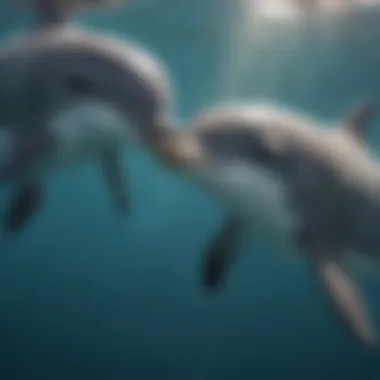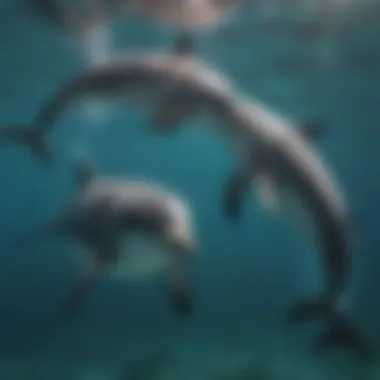Exploring Dolphin Mating Behavior: Do Dolphins Mate for Life?


Intro
Dolphins have long fascinated humans with their intelligence, social structures, and behaviors. Their mating practices offer a particularly intriguing look into not only their reproductive strategies but also the social dynamics that govern their interactions. This article examines whether dolphins form lifelong partnerships and sheds light on the complexities of their relationships.
Animal Profile
General Overview
Dolphins are marine mammals that belong to the family Delphinidae. They are known for their high intelligence and complex social behavior. With around 36 different species, dolphins vary in size, color, and habitat. Common species include the bottlenose dolphin and the orca. These highly social creatures communicate through a variety of vocalizations and body language, which plays a crucial role in their mating behavior.
Habitat and Distribution
Dolphins are found in oceans and seas around the globe. They thrive in both coastal and deep-water environments. Depending on the species, they may inhabit warm tropical waters or cold temperate regions. Their adaptability to different habitats has allowed them to flourish in diverse settings, from coral reefs to estuaries.
Fascinating Facts
Unique Traits and Adaptations
Dolphins possess several unique traits that enhance their adaptability. Their streamlined bodies allow for swift movement through water. Additionally, their echolocation abilities aid in navigation and hunting. Socially, they often form pods, which are groups that can vary in size. These pods provide support during mating and childcare.
Historical and Cultural Significance
Throughout history, dolphins have appeared in various cultures, often symbolizing grace and intelligence. Ancient Greeks regarded them as sacred animals, while some cultures view them as protectors of sailors. Their portrayal in art and literature continues to reflect human fascination.
Conservation Status
Current Population Trends
Many dolphin species face declining populations due to human activities such as fishing, habitat destruction, and pollution. For example, the population of the vaquita, a small porpoise found in the Gulf of California, has dwindled to critically low levels. Proper conservation measures are necessary to ensure the survival of these species.
Threats and Challenges
Dolphins encounter various threats that jeopardize their survival. These include:
- Bycatch: Accidental capture in fishing gear.
- Pollution: Contaminants in water can interfere with dolphin health.
- Habitat Loss: Coastal development impacts their natural environments.
"The social dynamics and reproductive strategies of dolphins provide key insights into their ecological needs and conservation strategies."
Care Tips for Pet Owners
Although many people dream of having a dolphin as a pet, it is crucial to understand the complexities of their care. Keeping dolphins in captivity is often detrimental to their health and wellbeing. Advocating for their conservation in the wild is a more ethical approach to interacting with these intelligent animals.
Basic Needs and Requirements
If one is involved in dolphin care at an accredited facility, it is essential to focus on:
- Space: Adequate pools for swimming.
- Diet: A balanced intake of fish and nutrients.
- Social Interaction: Time spent with other dolphins is critical for mental health.
Health and Wellness Tips


Maintaining the health of dolphins includes:
- Regular veterinary check-ups.
- Monitoring for behaviors indicating stress or illness.
- Providing enrichment activities to stimulate their minds and keep them engaged.
This exploration into dolphin mating behavior and their social structures deepens our understanding of their natural world and informs conservation efforts. By protecting their habitat and ensuring their social systems remain intact, we contribute to the preservation of these extraordinary marine mammals.
Understanding Dolphin Behavior
Understanding dolphin behavior is crucial for comprehending their mating rituals and social structures. Dolphins are not only complex creatures but also exhibit behaviors that reflect high levels of intelligence and social interaction. This section aims to shed light on the underlying principles that govern their relationships and mating practices.
Behavioral studies indicate that dolphins thrive in intricate social groups known as pods. These pods display specialized hierarchies and roles among members, which play a significant role in their interactions. By examining this social structure, researchers can reveal insights about dolphin communication, reproductive behaviors, and overall relationship dynamics.
Focusing on the social behaviors of dolphins allows educators, students, and biologists to better appreciate the nuances of their interactions. Such knowledge can enhance conservation strategies, as protecting these social groups often leads to healthier marine environments. Understanding how dolphins communicate and engage with one another is vital for all stakeholders focused on dolphin welfare.
Social Structure of Dolphin Pods
Dolphin pods can vary significantly in size, composition, and social structure. Typically, a pod consists of related individuals. The bonds within a pod are often maternal, where females usually remain with their offspring. Males tend to disperse, but some may form alliances that can last for years. This behavior illustrates the importance of both familial bonds and social cooperation among dolphins.
The social structure informs how dolphins engage in mating behaviors. Female dolphins may choose mates based on their social status and health. High-ranking males often gain access to more females. This hierarchy creates a competitive environment that shapes mating choices. Furthermore, pods may cooperate during mating seasons. Observations show that females can mate with multiple males, leading to a mix of genetic diversity within the pod.
Communication Among Dolphins
Dolphin communication is sophisticated and multifaceted. These creatures utilize various sounds, including clicks, whistles, and body language, to convey messages. Their vocalizations can indicate social status, mating readiness, and even individual identity. Acoustic signals also help dolphins maintain group cohesion and facilitate coordinated behaviors during hunting.
The communication methods observed in dolphins suggest a high level of social intelligence. For instance, regional dialects are common, which indicates that dolphins from different areas may have unique sound patterns. This specialization can have implications for mating, as compatibility may be affected by communication styles. Understanding these signals is essential for researchers studying dolphin mating systems, as it sheds light on how relationships form and evolve.
"The intricate social networks and communication methods among dolphins reflect not only their intelligence but also their adaptability in complex marine environments."
Dolphin Mating Rituals
Dolphin mating rituals are crucial in understanding the social interactions and reproductive strategies of these intelligent marine mammals. These behaviors not only shape the relationships among individual dolphins but also influence their overall mating success. Observing these rituals provides insights into how dolphins select partners, establish bonds, and maintain their social structures. Additionally, comprehending these rituals is significant for conservation efforts, as it helps identify essential behaviors that need protection in changing habitats.
Courtship Behavior
Courtship behavior in dolphins involves a series of intricate displays and interactions. Typically, male dolphins will engage in specific actions to attract females. These behaviors can include a combination of vocalizations, physical displays, and playful interactions.
- Vocalizations: Males often use a variety of clicks and whistles aimed at females. These sounds serve to convey their health status or emotional state.
- Physical Displays: Swimming in synchronized patterns, breaching, and acrobatic flips are common ways to showcase fitness and vigor.
- Playful Interactions: Play is an essential element of courtship. Males may engage in behaviors like chasing, nudging, and even mock fighting to captivate the attention of potential mates.
The courtship period requires depth of understanding. Mates may engage in these displays over several days or even weeks. This time allows both dolphins to assess compatibility before mating.
Mating Seasons and Timing
Mating seasons among dolphins are influenced by environmental conditions, food availability, and social dynamics within pods. Different species exhibit distinct mating patterns, often tied to biological cycles and habitat factors.
- Breeding Seasons: Most dolphin species have specific breeding seasons usually timed with the availability of prey. For instance, bottlenose dolphins may breed year-round, but peak mating occurs in warmer months when food is abundant.
- Timing for Mating: Dolphins are known to engage in mating behaviors during times of reduced social activity. Early mornings and twilight hours tend to see increased courtship and mating behaviors as it may offer privacy from the pod.
The timing of mating is vital in ensuring reproductive success. During favorable conditions, mothers can bear healthy calves, which enhances species survival in a natural habitat.
"Understanding dolphin mating rituals is not just about reproduction; it’s about their complex social lives and relationships, which are essential for their survival."
Mating rituals among dolphins provide a fascinating look into their lives. Studying them sheds light on their social structures and highlights the implications for marine conservation.


Do Dolphins Form Lifelong Bonds?
The examination of whether dolphins form lifelong bonds is important in understanding their complex social structures and mating behaviors. Dolphins are known for their intricate social interactions, and analyzing these relationships provides insight into their emotional and developmental needs. Understanding the nature of these bonds can also have implications for habitat conservation and management strategies, as it highlights the significance of social networks in dolphin populations.
Evidence of Long-term Relationships
Research indicates that some dolphin species exhibit long-term social relationships that extend beyond a single mating season. Bottlenose dolphins, for instance, are often observed in stable social groups known as pods. These pods can consist of related females and their offspring, but they may also include males who establish strong social bonds with one another. Evidence suggests that male dolphins sometimes engage in cooperative behaviors, such as helping each other in courting female dolphins, which further supports the notion of enduring social relationships.
In various studies, researchers have used observed behaviors and genetic analysis to assert that dolphins can recognize and return to past partners over extended periods. These social bonds are not solely based on mating, as they can involve emotional connections seen in behaviors such as synchronized swimming and playful interactions. Notably, these interactions are crucial for developing social skills essential for navigating their environments and establishing future mating opportunities.
Comparison with Other Species
When comparing dolphin bonds to those of other species, it becomes evident that they display unique traits. Many terrestrial mammals, such as elephants or wolves, also form strong social bonds and can exhibit long-lasting partnerships. However, dolphins' fluid social structures allow them to form and dissolve alliances more dynamically based on environmental and social contexts.
For example, in the case of chimpanzees, which are closely related to humans, there is often evidence of long-term bonds forming through kinship. In contrast, dolphins tend to show flexible social relationships that adapt according to their needs and resources. Such differences might be a reflection of their environments—terrestrial animals generally have stable home ranges, while dolphins often roam larger aquatic territories. This flexibility in social structure can complicate direct comparisons, yet it highlights the adaptability and intelligence of dolphins in forming bonds within varying contexts.
Reproductive Strategies in Dolphins
Reproductive strategies in dolphins are key to understanding their complex social structures and mating behaviors. These strategies encompass not only the biological aspects of reproduction but also the social dynamics that influence mating success. A deep understanding of these reproductive strategies helps to illuminate the ways in which dolphins navigate their social interactions and ensure the continuation of their species.
The importance of reproductive strategies cannot be overstated, as they directly impact population dynamics, genetic diversity, and overall dolphin health. When assessing these strategies, it is crucial to consider various elements such as courtship behaviors, mating systems, and the environmental factors that may influence reproductive success.
Breeding Strategies
Dolphins exhibit a range of breeding strategies that vary both by species and environmental context.
- Seasonal Breeding: Many dolphin species have specific breeding seasons. For example, common bottlenose dolphins typically mate in the warmer months. This timing aligns with increased food availability, enhancing the chances of reproductive success.
- Promiscuity vs Monogamy: Some dolphin species are known for their promiscuous mating habits, where both males and females mate with multiple partners. In contrast, certain groups may show signs of temporary monogamous pairings. These varying strategies reflect adaptability in reproductive behaviors.
- Parental Investment: Female dolphins invest significant time and energy into raising their calves. This includes not only the initial nurturing during gestation but also postnatal care. The emphasis on calf survival and well-being highlights the vital role of breeding strategies in sustaining dolphin populations.
Dolphins choose partners based on social hierarchy, ensuring that mating includes elements of competition and cooperation within pods.
Role of Gender in Mating
The role of gender in dolphin mating behaviors is marked by distinct differences in the approaches taken by males and females.
- Male Competition: Male dolphins often engage in competition to attract females. This may involve displays of strength, agility, or vocalizations. Dominance hierarchies within pods can also influence which males gain access to females.
- Female Choice: Female dolphins exhibit choice when selecting mates. They may prefer males with specific traits or those that demonstrate strong social bonds within the pod. The female's preferences play a critical role in mating success.
- Cooperative Breeding: In some instances, it has been observed that females may work together to rear calves, sharing responsibilities. This cooperative aspect of gender dynamics further emphasizes the complexities of dolphin reproductive strategies.
In summary, understanding reproductive strategies in dolphins provides essential insight into their social behavior, mating rituals, and overall survival. By examining both breeding strategies and the roles of gender in mating, we can appreciate the multifaceted nature of dolphin relationships.
The Impact of Environmental Factors
Understanding how environmental factors influence dolphin mating behavior is crucial for grasping the broader ecological context in which these animals thrive. Changes in habitat due to natural processes or human activity can significantly affect mating patterns and social structures within dolphin pods. As marine mammals, dolphins depend on a delicate balance of environmental conditions for their reproductive success and overall well-being. Factors such as water temperature, prey availability, and habitat quality are all components that can have profound impacts on dolphin behavior.
Both physical and biological elements play significant roles in shaping how dolphins interact and mate. For instance, a decline in fish populations due to overfishing can lead to increased competition among dolphins for food. This situation may result in altered mating behaviors as dolphins prioritize survival over reproduction. It is essential to consider these dynamic interactions when evaluating dolphin relationships and breeding strategies.
Habitat Influence on Mating
A dolphin's habitat can shape its mating strategies in various ways. The availability and quality of habitats impact the social structure of pods and, by extension, their mating behaviors. Coastal environments, for instance, often provide rich feeding grounds but may also face environmental stressors like pollution. In contrast, open ocean habitats may offer less food but promote different social interactions among pods.
When considering mating, proximity to suitable habitats can determine how frequently dolphins mate and the success of these pairings. Mating typically occurs more frequently in locations with abundant resources. If dolphins are forced to migrate due to a changing environment, their mating patterns may be disrupted. This can lead to significant biological implications, resulting in lower reproductive rates.
Additionally, the physical characteristics of habitat, such as depth and water clarity, influence dolphin communication and accessibility during mating rituals. The complexity of social interactions among dolphins requires a conducive environment to ensure successful mating.


Human Interaction and Its Effects
Human activities have a profound impact on dolphin mating behavior and overall health. The presence of boats, pollution, and coastal development disrupt the natural habitat, often leading to stress among dolphin populations. Increased boat traffic can create noise that interferes with dolphins' ability to communicate. This disruption can affect their social bonds and, subsequently, their mating behaviors.
Additionally, pollution can lead to health complications for dolphins, affecting their reproductive capabilities. Studies have shown that exposure to toxins in the water can lead to decreased fertility rates in marine mammals.
Moreover, entanglement in fishing gear and habitat destruction can isolate dolphin populations. When pods are separated, the chances of mating diminish. This isolation also impacts the genetic diversity within dolphin populations, which is particularly concerning for small, fragmented groups.
"Dolphins are constantly adapting to changes in their environment, but some impacts from human activity may be beyond their capacity to adapt."
Further research is necessary to examine the long-term implications of environmental changes on dolphins' reproductive strategies. With a greater understanding, we can work towards better conservation efforts that mitigate the adverse impacts of human activity on dolphin populations.
Conservation Implications
Understanding the conservation implications related to dolphin mating behavior and social structures is crucial. The delicate balance of marine ecosystems is often influenced by the reproductive patterns and social dynamics of dolphins. As key species in their habitats, their mating behaviors could offer insights into environmental health. Protecting dolphins means preserving biodiversity and maintaining ecological stability.
By studying how dolphins mate and form social bonds, we can better understand their roles in marine ecosystems. Promoting awareness about dolphin conservation helps garner support for protective measures. Conservation efforts lead to healthier oceans and promote the survival of various marine species. Additionally, educating the public about dolphin behaviors raises interest and encourages people to participate in conservation initiatives.
Protecting Dolphin Habitats
Habitat protection is fundamental for the sustainable future of dolphin populations. Dolphins thrive in environments that are clean and abundant in food and space. Unchecked development, pollution, and climate change negatively affect their natural habitats. Consequently, conservation measures must focus on:
- Creating Marine Protected Areas (MPAs): These zones restrict human activities that can harm dolphin habitats. They provide safe spaces for reproduction and nurturing.
- Regulating Fishing Practices: Overfishing and bycatch threaten dolphin food sources. Implementing sustainable fishing practices helps secure their diets.
- Addressing Pollution: Reducing plastic waste and chemical runoff ensures healthier waters for dolphins to live in. Communities must work together to combat pollution on local and global scales.
Active engagement in habitat protection leads to better conditions for dolphins, allowing them to thrive in their natural ecosystems.
Understanding Population Dynamics
Population dynamics is essential for assessing dolphin conservation strategies. Monitoring population sizes helps researchers identify trends related to mating behaviors and social structures. Key factors in population dynamics include:
- Reproductive Rates: Understanding the frequency and success of dolphin reproduction aids in estimating population growth.
- Mortality Rates: Analyzing threats that increase death rates, such as pollution and human interference, can inform prevention strategies.
- Migration Patterns: Knowing how and why dolphins migrate helps to protect critical habitats during various life stages, such as breeding.
- Genetic Diversity: Maintaining genetic diversity is vital for a healthy population. High genetic variability reduces the risk of disease and enhances adaptability.
By comprehending the population dynamics of dolphins, conservationists can devise targeted strategies that support long-term preservation efforts. Furthermore, informed policies based on population studies can lead to the enactment of protective legislation, ensuring dolphins continue to thrive in the wild.
Finale: The Complexity of Dolphin Relationships
Dolphin relationships are a rich tapestry shaped by social, environmental, and behavioral factors. Understanding these complexities is crucial, as they provide insights into the ecological dynamics of marine life. This article has explored diverse aspects of dolphin mating behavior and social structures, emphasizing that species such as dolphins are far from simplistic.
The discussion has revealed that dolphins exhibit a range of relationship types. Some develop long-lasting bonds, while others engage in temporary partnerships during mating seasons. Different populations even display unique social structures and mating rituals, which can be crucial for their survival and reproduction.
The implications of these relationships extend to conservation efforts. Properly understanding dolphin social dynamics can inform effective protection strategies. For instance, knowing how environmental factors influence mating behavior can assist in habitat preservation—thus reinforcing the urgency to protect delicate marine ecosystems.
In the realm of research, it is vital not just to focus on the reproductive aspects but to take a broader view that encompasses the social structures dolphins maintain. Such insights can enrich our understanding of the marine world and guide management and conservation policies.
This exploration contributes to an ongoing dialogue about the complexities of animal relationships beyond typical human-like interpretations. As science continues to unveil new findings, the question of whether dolphins form lifelong bonds may yield varied answers, highlighting the need for continuous study and observation.
Revisiting the Lifelong Bond Debate
The debate surrounding lifelong bonds among dolphins remains a contentious topic among researchers. Observational studies suggest variances in pair formations, but distinct patterns have emerged. Some dolphins do exhibit signs of strong, enduring attachments, while others engage more casually.
Key observations include:
- Long-term associations: Evidence points towards certain dolphin pairs that are frequently seen together over extended periods, sharing social interactions and caring for young.
- Temporary bonds: There are also cases where individuals form short-term relationships primarily for mating purposes. These connections can be influenced by factors such as food availability and environmental pressures.
- Variability within species: Differences are often seen among various dolphin species. For instance, bottlenose dolphins show varied relationship dynamics compared to orcas, who may display different bonding tendencies.
The dynamic landscape of dolphin relationships underscores the need for a deeper understanding of their social lives. The concept of lifelong bonds may not fit neatly into a singular definition. Researchers must consider ecological, behavioral, and anthropological frameworks.
Ultimately, revisiting this debate reflects the intricacies of dolphin behavior. It encourages further study that may enrich our understanding of not only dolphin ecology but also the broader implications for wildlife relationships in general. Through ongoing research, we can appreciate the depth of connections these intelligent creatures form in their ever-changing social world.















